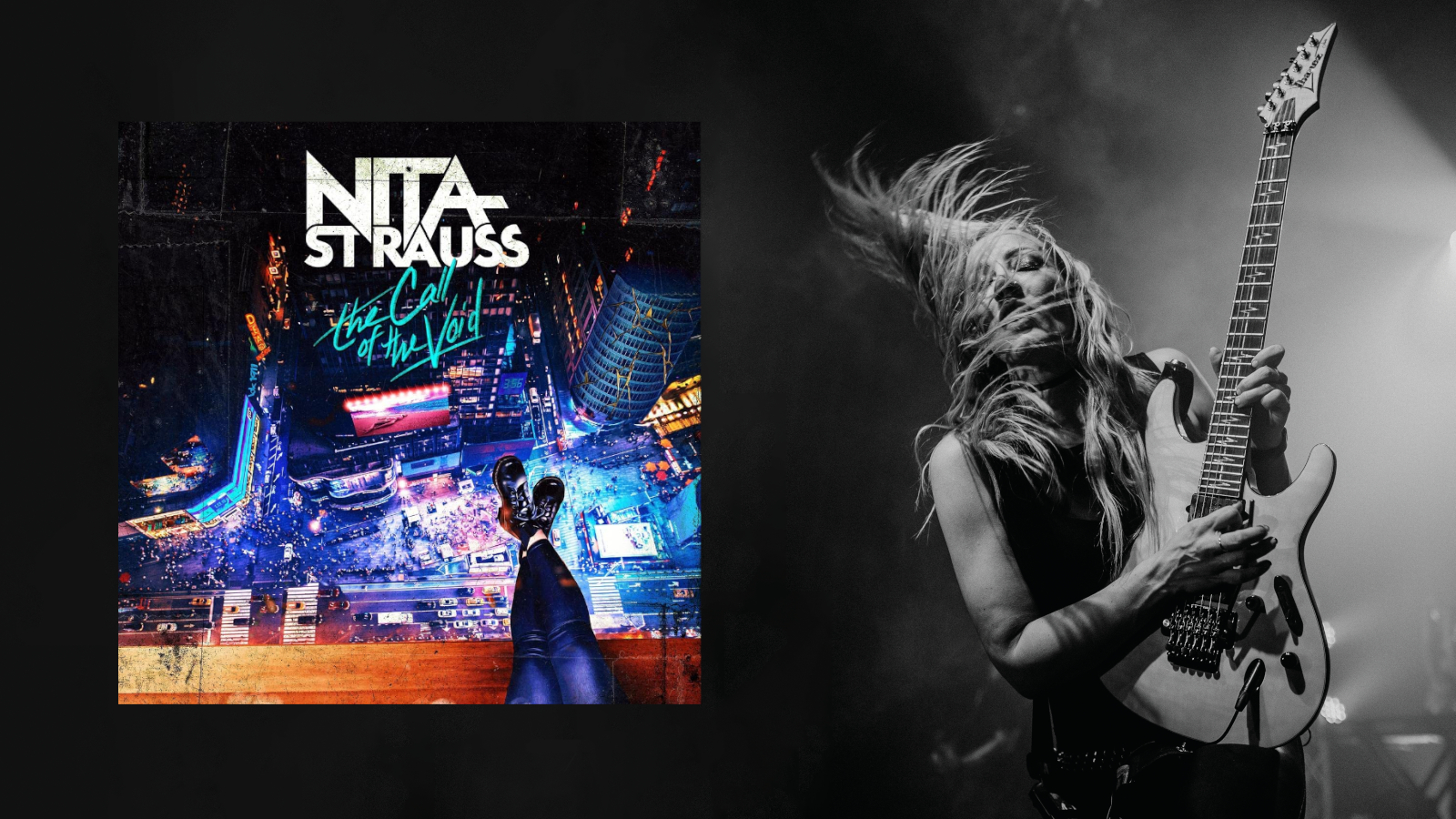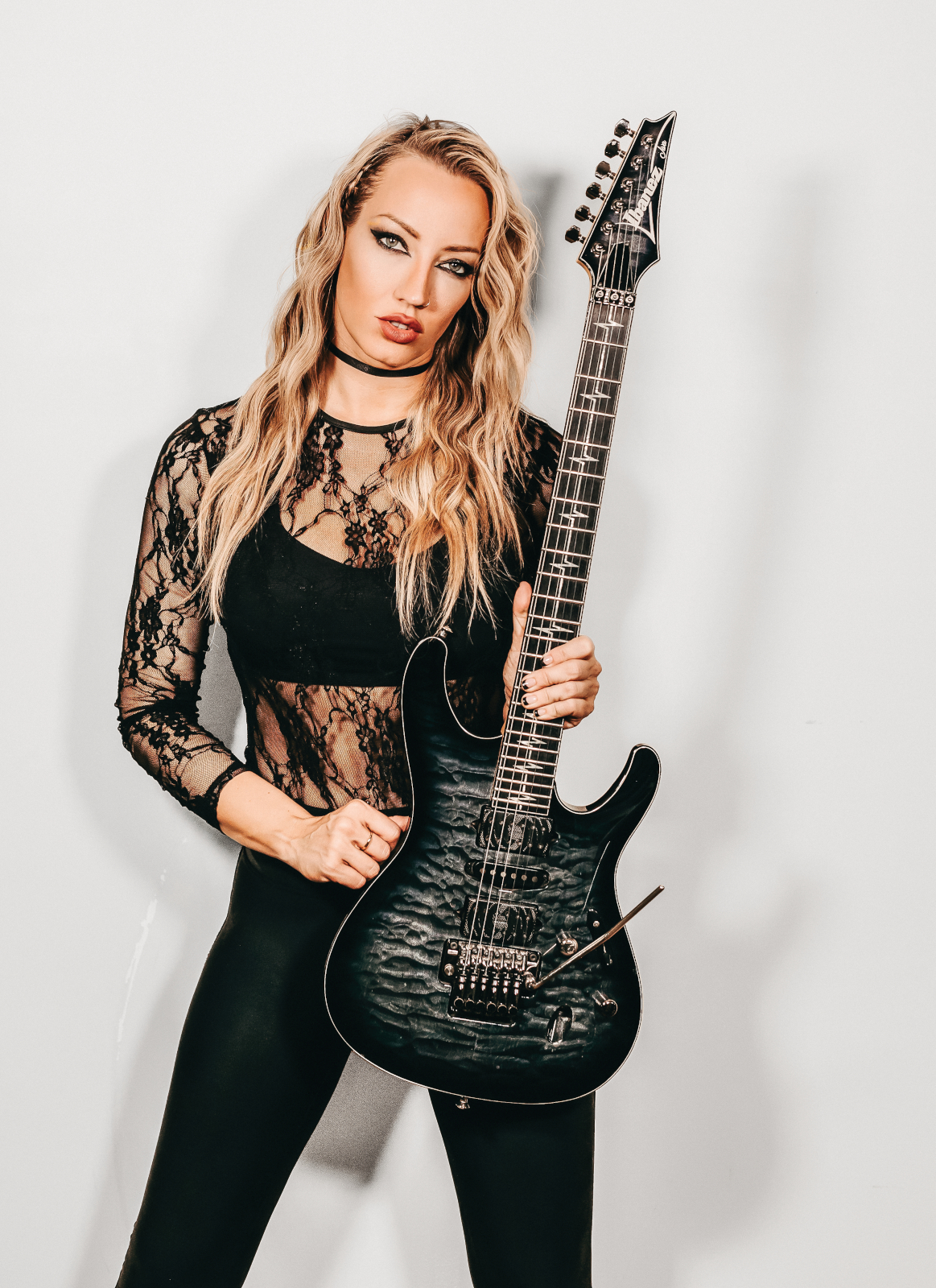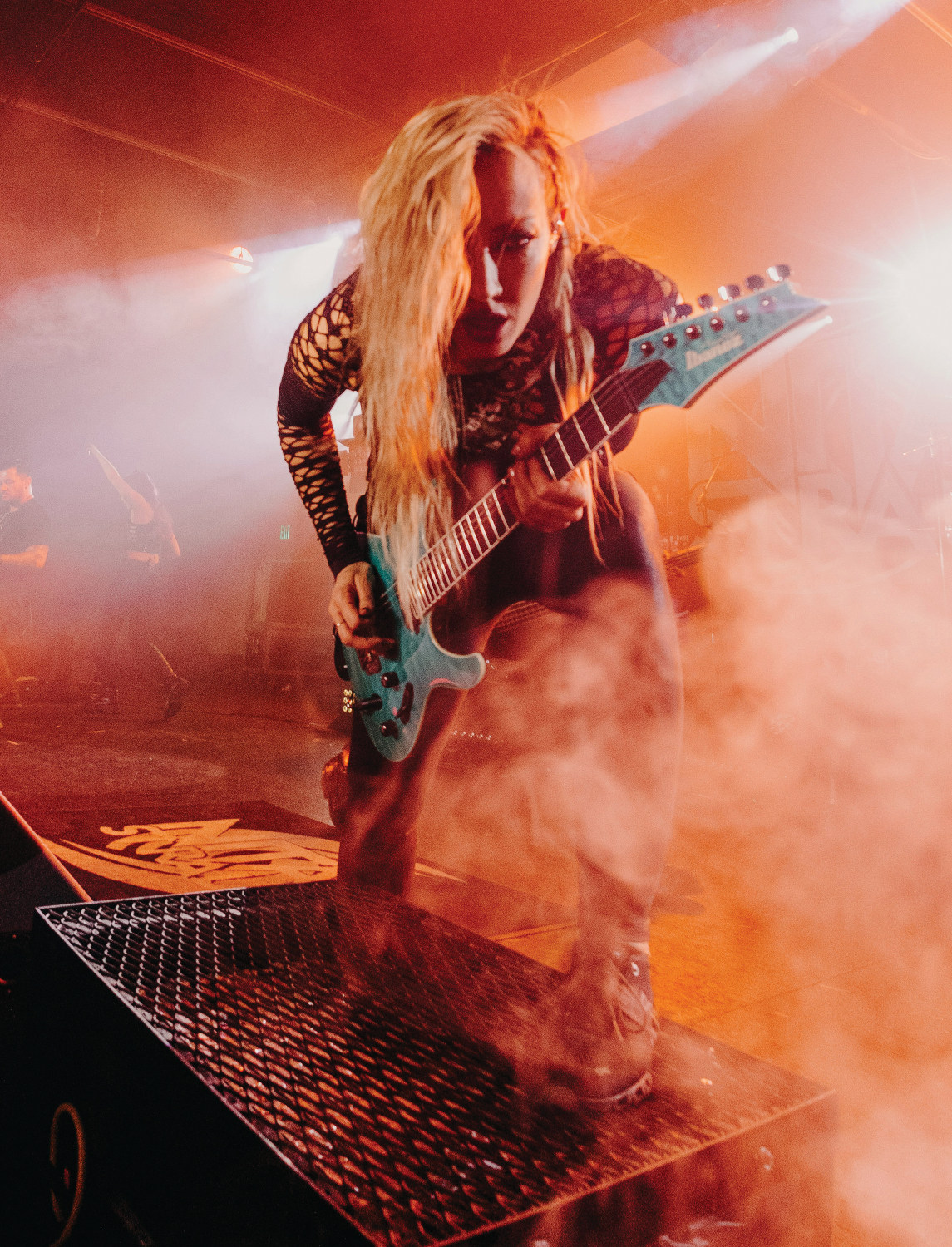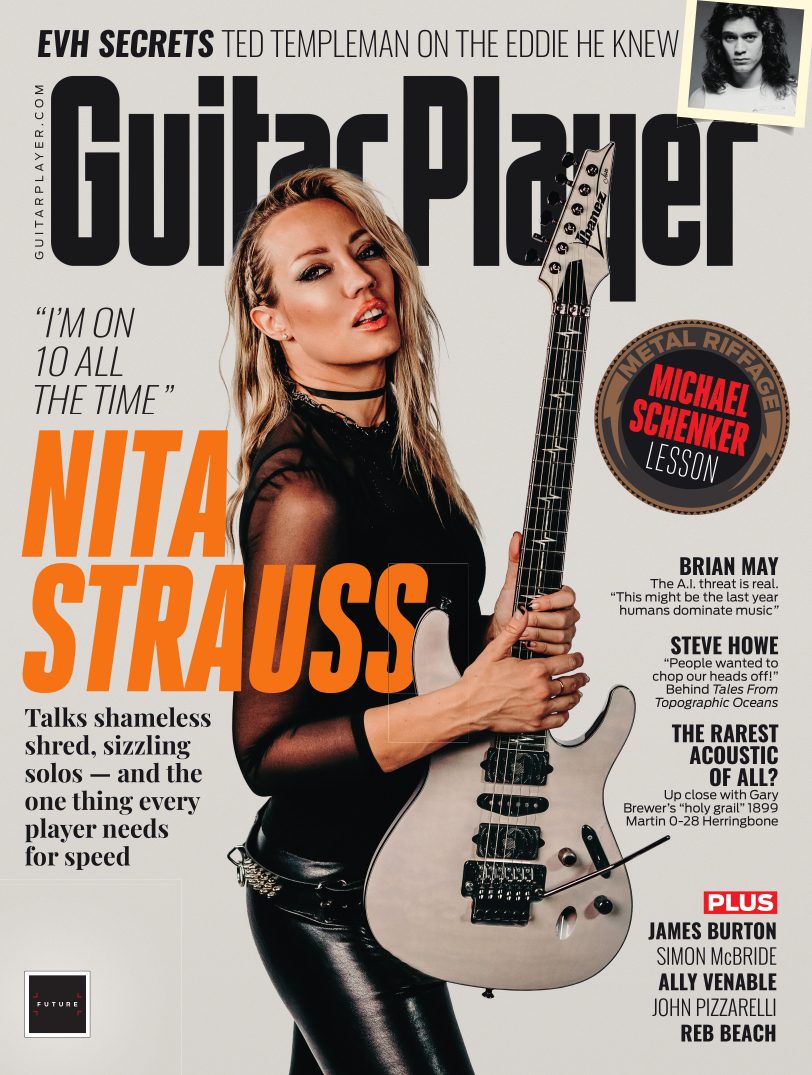
“I write very emotional music, and most of the time it’s pretty angry,” says the reigning queen of shred metal, Nita Strauss. Right now, however, she’s the picture of morning contentment. Speaking with Guitar Player via Zoom, the guitarist is happily seated in the back of her tour bus, having wrapped the first date of her Summer Storm solo tour the night before in Nashville. On her lap are her two dogs: Bentley, a Pomeranian Chihuahua mix, and Motley, a Chihuahua mix. Strauss pats their heads and strokes their fur.
“The back lounge of the bus is their little kingdom,” she says. “They have everything they need, and they love it when people come by to visit them. They’re true little road dogs. I take them out on all of my solo tours. When I’m playing with other people, I have to leave them home, but when I do my shows, I get to set the rules.”
It’s breakfast time, so Strauss pours some food in a couple of bowls and sets her canine pals down to eat. She smiles as she watches them, then turns her attention back to the subject of music. “Playing the guitar and writing music is therapy for me,” she says. “I’m typically a pretty happy person. I’m not angry, although I have stress like anybody else. I don’t get into fights at the drive-thru. It’s interesting, though: When I pick up the guitar, I let it all out and go wherever my creative journey takes me. It usually takes me to some aggressive places.”
That’s certainly true throughout much of her second solo album, The Call of the Void (Sumerian Records), a relentless – and relentlessly thrilling – collection of scorching metal that showcases Strauss’s lethal virtuosic abilities as both a guitarist and songwriter. Whereas her first record, 2018’s Controlled Chaos, was an all-instrumental affair that proved she could whip up an old-school neo-classical storm, the new album is a more future-forward set aimed at mainstream rock and metal audiences.
More than half of the record features vocals from a variety of aggro guests – among them, Disturbed’s David Draiman, Halestorm’s Lzzy Hale, Dorothy Martin (from the band Dorothy) and In Flames’ Anders Fridén. Even Strauss’s longtime employer, shock-rocker Alice Cooper, turns up and delivers the goods on the righteous arena-rock anthem “Winner Takes All.”
“I like to operate on 10 all the time, so for me, playing on the vocal songs was a real challenge,” Strauss explains. “Whenever people talk about ‘taking things to the next level,’ I always think about going to 11 – you know, pedal to the metal. On straightforward rock songs, like ‘Victorious’ with Dorothy or ‘Through the Noise’ with Lzzy Hale, I had to try to do what I wanted guitar-wise without stepping over their vocals. Even the song I did with Alice, I had to tell myself, ‘Hey, let him sing!’”

She laughs and recites Yngwie Malmsteen’s famous line, “How can less be more? It’s impossible. More is more!” “That’s always been my attitude,” she notes. “I would think, All right, I have this main part, and then I have this minor-third harmony. Now I can double the main line up an octave – but maybe it would be better to have three, four or five harmony parts? And hey, I can put a little arpeggio in there, too. It can get a little crazy.”
All the latest guitar news, interviews, lessons, reviews, deals and more, direct to your inbox!
And indeed, on The Call of the Void she does go a little bonkers in the Yngwie sense. Many of the album’s cuts – instrumentals as well as vocal tunes – are packed to the gills with mesmerizing, high-flying guitar harmonies that at times reach operatic heights. “It was all about balance,” she says. “I had to keep reminding myself that not all of my big ideas had a place on any given song, which runs counter to my intuition. Being on 10 is my comfort zone, but occasionally I have to dial it back.”
She points to the exotic ballad “Kintsugi” as prime example of this kind of restraint. Only Strauss and her keyboardist, Katt Scarlett, appear on the track, which features blistering, fleet-fingered runs. At its core it’s an affecting study in legato melodicism, and it succeeds in casting a mystical spell.
“I’m so proud of that song,” Strauss says. “It’s very pure, and the emotion comes from a different place than the other cuts on the album. I didn’t use any fancy tricks – I didn’t use a lot of gain or anything like that. It’s very simple and evocative. To be honest, I didn’t know I could do something so sparse. It’s just the guitar and keyboard having a conversation. I didn’t need anything else.”
Nor did she need a lot of added musicians on the album. Aside from herself and Scarlett, the only other player is her drummer, and longtime boyfriend, Josh Villalta. They’re both part of Strauss’s touring band, which includes guitarist Johnny Young and bassist Dean, as well as singer Kasey Karlsen, a social media star and vocalist for the group Deadlands. “I’m so psyched about this band,” Strauss says. “To have Josh and Katt with me is awesome. Everything I do musically involves them. And Kasey is killing it. She did her first show with us last night, and she floored everybody. We’re having a blast.”
The brief Summer Storm tour saw Strauss return in August to her main gig with Alice Cooper (a spot she’s held down since 2014, one in which she shares guitar duties with another band veteran, Ryan Roxie). Last year, she caused a stir among fans when she split the Cooper camp and took up with Demi Lovato for a reinvention of the pop singer’s sound. Strauss added plenty of metallic crunch to Lovato’s bracing alt-rock album, Holy Fvck, and performed live dates as a member of the singer’s all-female band.
“There was some confusion about me going off to play with Demi, and I was surprised at the blowback,” Strauss says. “I was never ‘quitting’ Alice. There was a tour with Demi, and I talked to Alice about it – ‘Hey, are you okay with this?’ He said, ‘Absolutely. Go do it, and we’ll be here next year if the schedules work out.’ He gave me his complete support. Kane Roberts stepped in for me with Alice, and he did a phenomenal job. There weren’t that many dates with Demi this year, and there were a lot of dates with Alice, so it made sense for me to come back. There was zero drama.”
This year marks my 20th year as a touring guitarist. If there’s one thing I’ve learned, it’s ‘Man makes plans and God laughs'
Nita Strauss
She picks her pooches back up and considers the road ahead. “I’m in a really good place,” she says. “This year marks my 20th year as a touring guitarist. If there’s one thing I’ve learned, it’s ‘Man makes plans and God laughs.’ No matter what you’ve envisioned, something will happen and it all changes in front of you. I’m taking things one step at a time – getting this record out, a solo tour, touring with Alice, some one-offs with Demi and then game-planning the next solo record. If I looked back five years, I couldn’t have imagined where I am right now.”
It’s interesting. The press never calls female singers “female singers.” But if a woman picks up a guitar, she’s a “female guitarist.” A woman who plays drums is a “female drummer,” and so on. Aren’t you sick of all that?
Honestly, it doesn’t bother me at all anymore. Maybe when I was younger and had a chip on my shoulder, I’d be like, “I don’t want to be a female guitar player; I just want to be known as a guitar player.” But I’ve been touring for so long now, and the world of women in guitar is very different than when I started out. At the end of the day, to be in the conversation is a great thing. If we’re talking about great female guitar players, or great guitar players from Los Angeles, or great guitar players with blonde hair, or whatever, I’m focused on the “great guitar player” part.
At the same time, though, you’ve talked about how happy you are to be the first female to have a signature guitar with Ibanez. Last year, you said that you hoped Demi Lovato’s band could inspire women musicians. Is there a dichotomy there?
Maybe a little, when you put it like that. Look, let’s just get down to the harsh reality. You can be the best heart surgeon in the world, and there will still be a guy out there saying, “I don’t want a woman operating on my heart.” There are still stereotypes to break down – it is what it is. We have a song on the new record called “Victorious,” which is not meant to be a girl anthem, but it’s taken on the role of a girl anthem. It’s for anybody who struggles with self-doubt, and that’s not limited to the female gender. I know a lot of insecure guys.
By and large, it’s important to encourage people. When I was growing up, I didn’t have a lot of women to look up to in the guitar field, so if I can somehow inspire the next generation of girls who want to pick up a guitar and learn to play, I’ll gladly do what I can.
I would think that you already are an inspiration. Do you have girls come up to you at shows and say, “I picked up the guitar because of you”?
All the time. I can’t put into words how much that means to me. It’s not just little girls – it’s 50-year-old men and women who are retired. Their kids are grown, and they want to learn how to play guitar. I really get all kinds, and I love it.
If I can somehow inspire the next generation of girls who want to pick up a guitar and learn to play, I’ll gladly do what I can
Nita Strauss
Let’s talk about shred guitar. Who lit that fuse for you?
I loved the Shrapnel guys – Paul Gilbert, Marty Friedman, Jason Becker. Of course, I loved Steve Vai and Joe Satriani. This was when I was 13 years old. Then I saw Steve Vai in Crossroads – he was so cool and charismatic. At the time, I had a guitar, but I hadn’t fallen in love with it yet. I remember watching Steve Vai and thinking, Why didn’t anybody tell me that you could do that with a guitar? That is so cool!
After that, I started devouring anything I could get my hands on. I got the instructional DVDs by John Petrucci, Marty Friedman and Yngwie Malmsteen. It was all too advanced for a beginning guitar player, but I was into it. My family didn’t have a lot of money, so we couldn’t afford private lessons. Those DVDs were my teachers. I would sit there watching the screen, just picking out the patterns as best I could. That’s how I learned.
What was it about shred guitar music that spoke to you as opposed to other genres at the time?
The fact is, you had to seek out the music; shred wasn’t being played on the radio. Oh, it was hard to find, for sure. I got into really heavy music, bands like In Flames, Childen of Bodom, Soilwork… I loved the European metal, but of course I loved our American heroes Metallica and Megadeth too.
I think the music brought me out of my shell. I’m a naturally quiet person. I’m not super outgoing; I didn’t have an easy time making friends in school. When I started playing in bands, it was like this whole new community accepted me. I could almost play a character version of myself. I could get onstage and become somebody who was confident. At the same time, I had a hard time starting a conversation with kids my own age. But I knew that if I played guitar, they would listen and they would pay attention. I fell in love with communicating through music and performance.

It’s like how many shy kids excel in sports.
I did that, too. I grew up doing rhythmic gymnastics, and I would fly all over the country and compete. I had friends in my gym, but I still couldn’t hold a conversation with anybody at school.
What would you say is the most important shred technique – maybe something you learned early on that still matters today?
Good question. Hmm… I would say legato playing. It’s something I picked up on very early, and I still lean on it quite a bit. I think a big part of that is because I’m self-taught. Any self-taught guitarist will tell you they have holes in their playing. I’m not as well-rounded as I could be.
My right hand isn’t as strong as my left; I’m a very left-hand dominant player. That just came from being a young guitar player who didn’t know what was important. It was easier to move my left hand around, so I kept working harder on it. In a way, that ended up serving me very well, because later on my right hand caught up and I can do all the fast picking now. But I know that I’ve leaned heavily on my left hand since the very beginning.
I love playing fast, believe me, but you have to know when to put on the brakes
Nita Strauss
It’s interesting that you say legato playing. For a lot of shred players, that technique takes a back seat to high-speed flash.
I know, which is crazy! I love playing fast, believe me, but you have to know when to put on the brakes. Teaching myself how to play wasn’t the smartest way to do it – I’m just being honest. If I could go back and take proper lessons with somebody who knew how to teach a young guitar player, I would probably be a very different guitarist than I am today. I’d certainly be a more complete player. But this is where I’ve landed, and all things for a reason. It’s working.
You mentioned how Steve Vai in Crossroads got you interested in shred guitar, but the movie itself concerned a young blues musician. Did blues come into the picture when you were starting out?
I wouldn’t say it was a major influence. Of course, I had Texas Flood by the great Stevie Ray Vaughan.
That’s funny. A lot of people who don’t listen to blues have a Stevie Ray album.
That’s true. Later in my career, I got into more modern blues players, like Joe Bonamassa. He was actually at my show in Nashville last night – so no pressure, right? I look out and there’s Bonamassa. Wow! [laughs] He texted me after the show – “Big tone.” Coming from him, it was the greatest compliment I could ever ask for. As far as modern blues goes, he is just the pinnacle of what’s going on.
I asked because it seems that a lot of metal or shred players just pass right over the blues.
Right. They do.

Given that, how then did you approach playing much of Alice Cooper’s material? Take a song like “I’m Eighteen,” which is very R&B-based rock and roll – you could play it on an acoustic.
Exactly.
How does a shredder come at something like that?
It was kind of an education process. When I got the confirmation that I was going to be on the Alice Cooper tour, I wound up taking my first actual guitar lesson.
Why exactly?
To learn, basically. I talked to [longtime Alice Cooper producer] Bob Ezrin, who was a big part of my audition process, and he said, “Alice Cooper doesn’t need a shred guitar player. He needs a rock guitar player. Can you become a rock guitar player in time?” I said, “Absolutely. I know I can do it.” This was two weeks before the start of the Alice Cooper-Mötley Crüe tour. When I hung up the phone, I was in a daze. I remember looking at my phone and thinking, “Wow… Bob Ezrin just told me I don’t know how to play rock guitar.”
That’ll wreck your confidence.
Yeah. I was like, “I need to figure out what he means – a ‘rock guitar player.’” I called around and found a great teacher. I came in and showed him my audition videos. I said, “What the fuck does he mean?”
My teacher was the first person to really teach me how to incorporate blues licks into my playing, like adding the blues note into the minor pentatonic scale – these little licks and things. AC/DC riffs, Kiss riffs and licks. Ace Frehley’s stuff worked seamlessly with my style of playing, but they added that extra nuance that made it feel a bit more like a classic-rock vibe.
When I got the confirmation that I was going to be on the Alice Cooper tour, I wound up taking my first actual guitar lesson
Nita Strauss
What you’re describing is reverse engineering. A lot of the guitarists you first admired – Satriani and Vai, for example – came up listening to blues-based players. Their style of playing then morphed into what we call “shred.”
Completely. Reverse engineering – that’s the perfect term for it. We reverse-engineered my guitar playing to fit what it needed to be. You know, we talked about being a complete player and the gaps in my knowledge – the blues part was a big gap for me. I think that happened because I taught myself. When I was younger, I didn’t have the discipline to start from the beginning. I just skipped ahead to what I wanted to do.
Once I addressed that hole in my playing, it made me a stronger guitarist overall, and it allowed me to incorporate that style into what I do. If you listen to the new record, you’ll hear a lot of these little blues licks that I’ve learned over the course of playing with Alice. Also, Ryan Roxie, who is a fantastic, very rock and roll blues-based player – there’s a lot of little Ryan Roxie tips and tricks in there, as well.
With the exception of “Kintsugi,” you tend to favor a big, orchestrated guitar sound on the album – lots of harmonized parts. Where does that come from?
Probably all the bands I grew up loving – Iron Maiden, In Flames, Children of Bodom, Arch Enemy. They gave me an appreciation for two guitar players doing minor-third harmonies.
Do you think you might explore the approach on “Kintsugi” in the future?
You never know. That one felt right at the time. I didn’t start out with the intention of doing it – it’s just what the song needed. If another song pops into my brain that needs it, absolutely.
Take me inside your process for writing instrumentals like “Summer Storm” and “Consume the Fire.” With the upfront knowledge that guitar players will like them, how do you try to make the songs appeal to non-guitarists?
Honestly, this may sound selfish, but I don’t do it for either of those reasons. I write the instrumental stuff for me. I don’t even think about the audience. These songs are pure, unadulterated creativity in a solo sense. I don’t work with other musicians or co-writers. It’s like a therapy session, and I get to explore whatever I’m thinking about. I’m always surprised at the reactions I get, and I’m so flattered that non-guitar players really get into these songs. The vocal songs get a lot of people in the door, but they stay for the instrumentals.
“Scorched” is a stately, elegant, mid-tempo instrumental. I hear bits of Satch, but mostly Vai, the way he orchestrated his guitars on Passion and Warfare. Am I in the right lane there?
Oh, my, what a compliment! I would say you’re in the right lane, although I didn’t really start out trying to emulate Steve Vai’s sound. I think it just happens naturally; having played for so many years in two- and three-guitar bands, harmonies are my wheelhouse. Everybody I work with knows that I’ll add harmonies upon harmonies upon octaves – to the point where it can be a bit much. [laughs]
These songs are pure, unadulterated creativity in a solo sense
Nita Strauss
When you write instrumentals, do you always have a guitar in your hands? Do you sometimes start with a melody or a riff that pops into your head while you’re walking around?
You don’t get to choose when the muse comes. Sometimes I’ll have a guitar with me, but other times I might be walking around thinking about a song. I usually try to have a story that I want to tell, and I try to come up with note choices and arrangements that serve the story. I think that’s why my songs appeal to people who aren’t guitar players; they might not have words, but they’re about something.
Who in your opinion is pushing the boundaries of instrumental shred? Who’s taking it somewhere new?
Oh, my gosh, I feel like we’re in a golden age for it. Look at what Angel Vivaldi is doing. Look at what Yvette Young is doing. Tim Henson and Scott LePage from Polyphia, Tosin Abasi, Jason Richardson. These players are advancing the music to a place that people couldn’t even conceive of 10 years ago. I watch Tim and Scott do what they do, and it makes my jaw drop. I would say that the world of instrumental guitar is in a very good place.
Anything new on the horizon for your signature guitar? Are you planning an update?
I have something cooking for a new JIVA model, but I’m holding off putting the wheels in motion until the new JIVAX2 Ghost is shipping more consistently. The pre-orders started at the last NAMM, and the first shipments are just starting to arrive now. A lot of people pre-ordered a very expensive guitar, and I think it would be a slap in the face if I said, “I know you haven’t gotten that guitar, but hey, here’s a new one.”
Did you use any new gear on the record?
I experimented with a lot of different plug-ins – that was new for me. We used some of the Neural DSPs and some Steven Slate stuff. I liked using a Slate mic because of the modeling aspect. As far as live gear, I still used my signature guitars, and I can’t beat a Marshall amp. I use the Satriani JVM series of amps.
You’re big into fitness. Is that how you keep yourself together?
Between the rigors of touring, plus everything else you’re involved with, you’ve got a pretty full schedule.
It gets pretty hectic. For me, it’s all about getting into a routine and sticking with it. The way my days are set up, I have to get to it right when I wake up. I take my vitamins, drink my green shake, and then I do my workout. If I don’t get that workout in, I won’t do it at all. It’s so important to stick to a routine, mentally and physically. You have to fuel your machine.
It’s admirable how seriously you take physical and mental health. I’m sure you’ve seen some musicians go down a bad road.
I have, but it’s less and less common now. More musicians than ever are prioritizing their health. I go on tour buses and people are like, “We drink this green drink, and we use this protein powder.” It’s not drugs and partying and girls anymore. Everybody has calmed down. We keep the craziness for the stage.


Joe is a freelance journalist who has, over the past few decades, interviewed hundreds of guitarists for Guitar World, Guitar Player, MusicRadar and Classic Rock. He is also a former editor of Guitar World, contributing writer for Guitar Aficionado and VP of A&R for Island Records. He’s an enthusiastic guitarist, but he’s nowhere near the likes of the people he interviews. Surprisingly, his skills are more suited to the drums. If you need a drummer for your Beatles tribute band, look him up.




